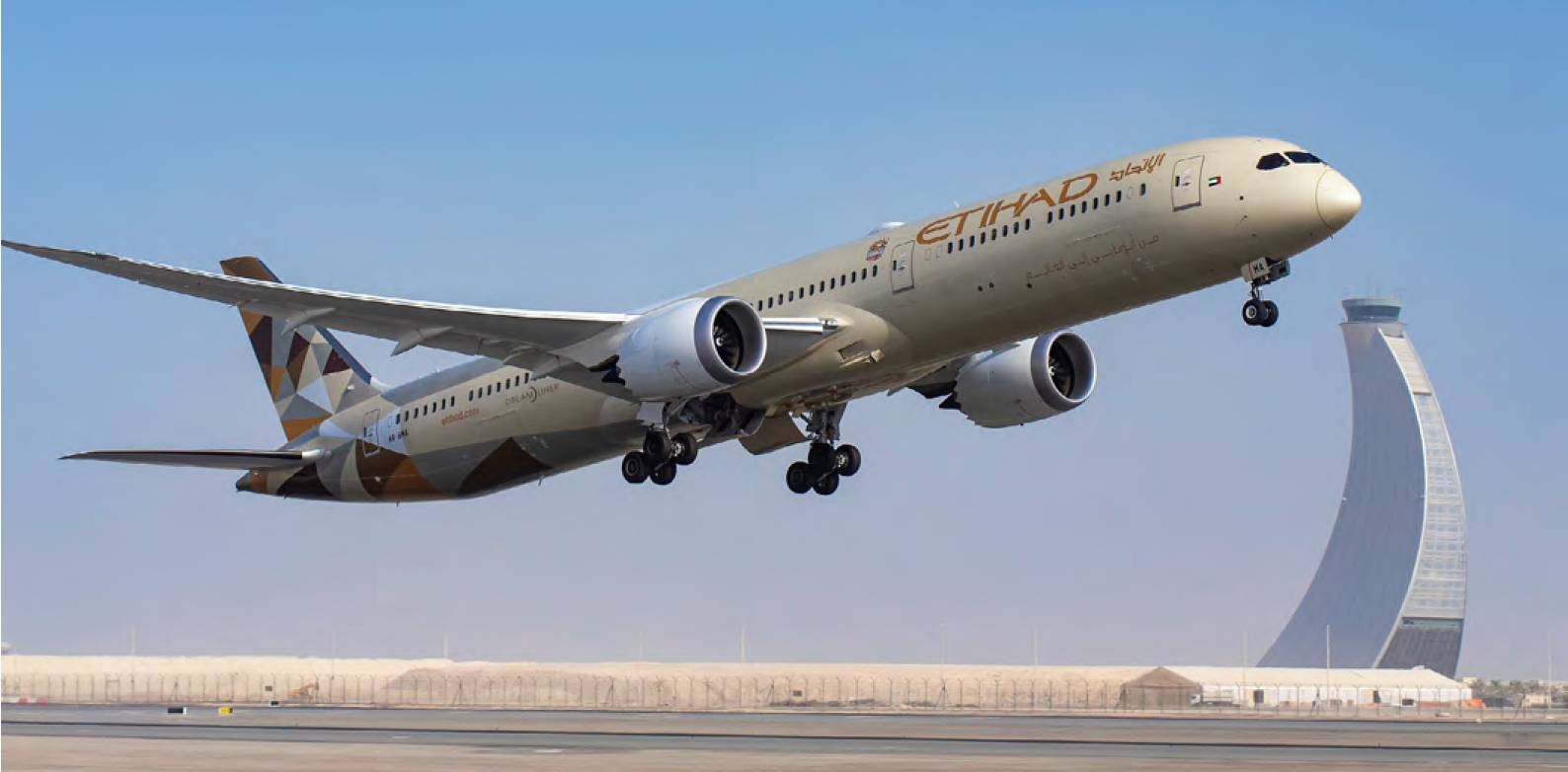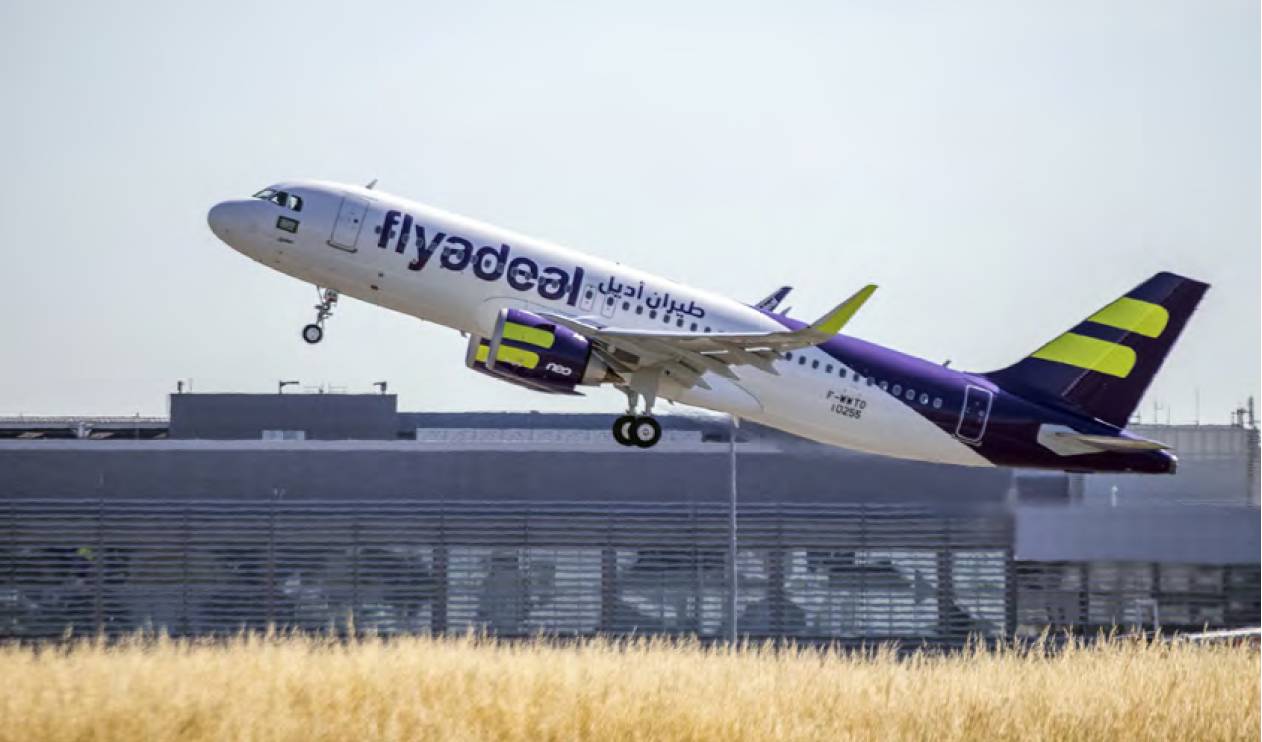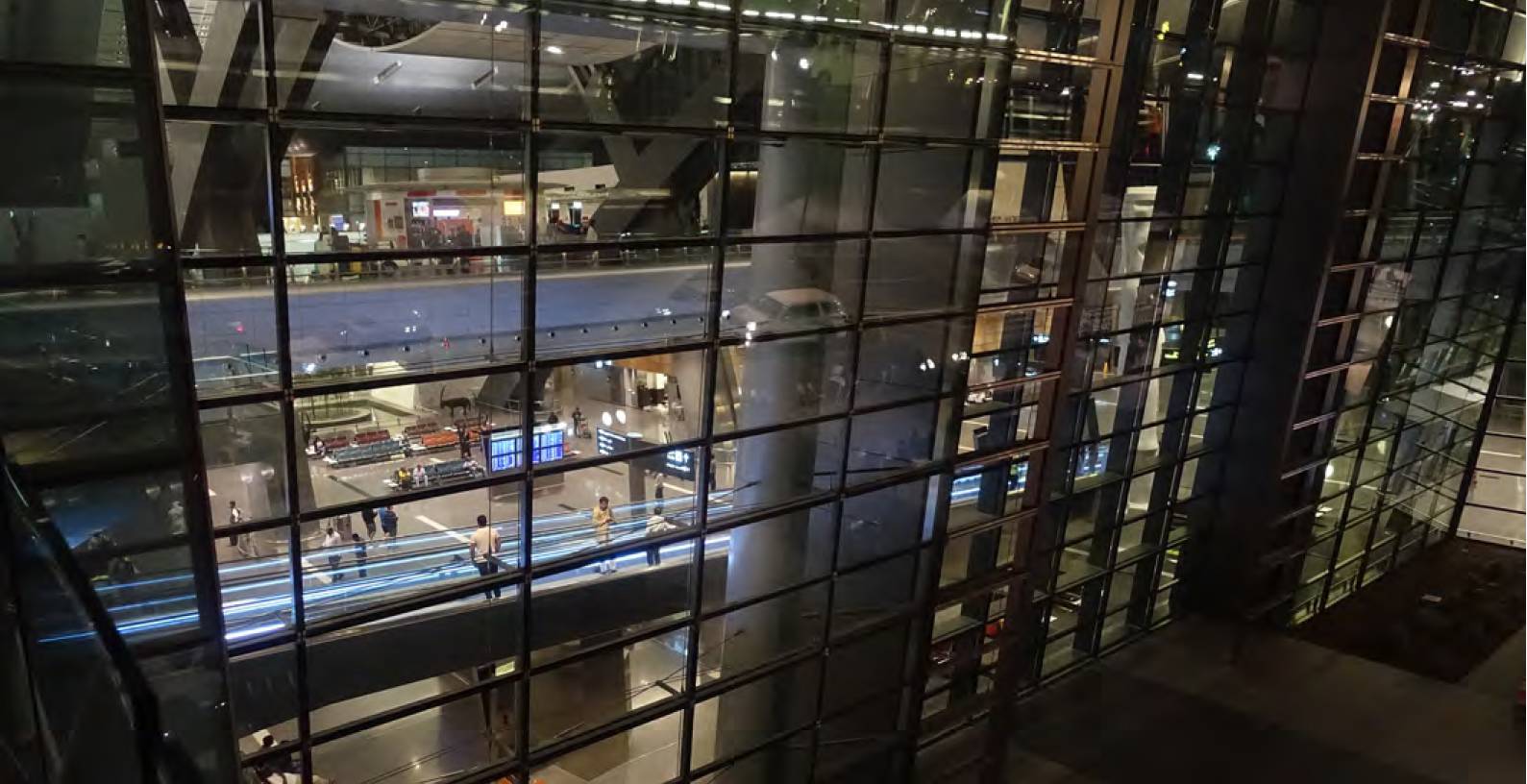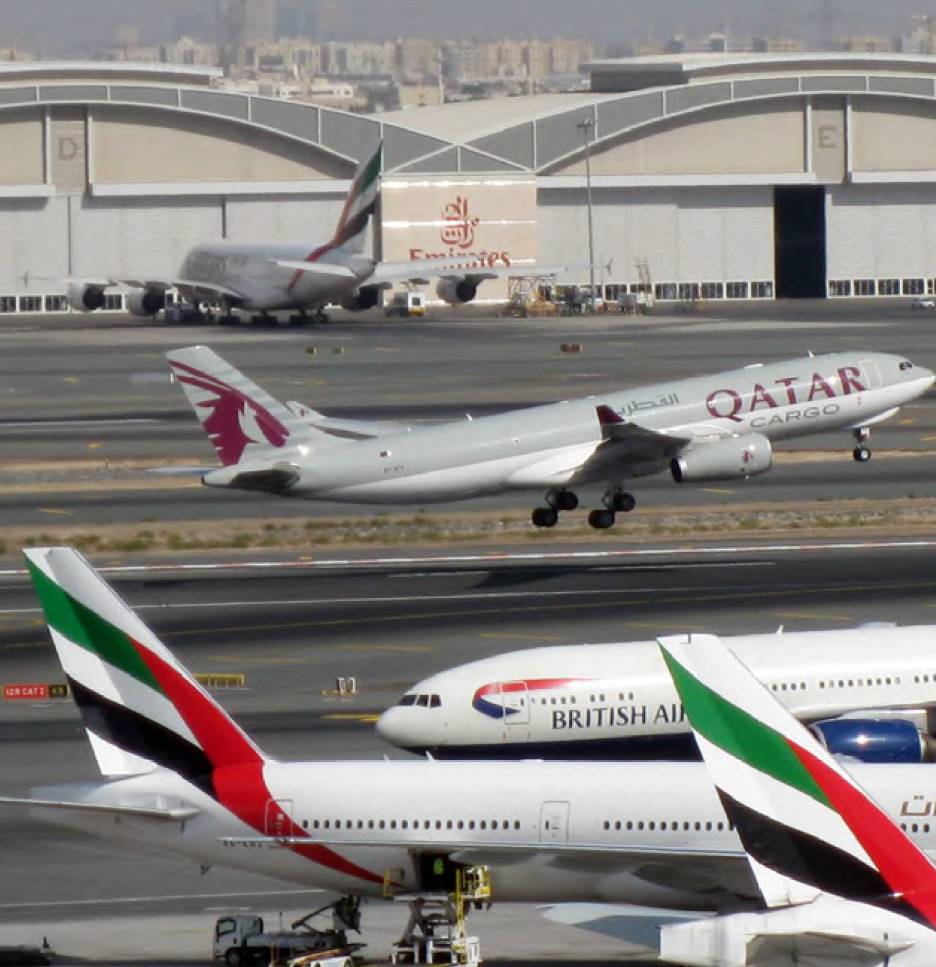AIR TRANSPORT Middle Eastern airlines
Shifting sands
As international air travel slowly returns after the Covid-19 pandemic the Gulf mega-carriers face new challenges to regional dominance – Saudi Arabia and an influx of low-cost carriers. ALAN DRON reports.
 Etihad Airways Boeing 787-9 departing from Abu Dhabi. Nabeel Hashmi
Etihad Airways Boeing 787-9 departing from Abu Dhabi. Nabeel Hashmi
For the past two decades, the Middle East – together with China – has been one of the growing centres of gravity of the airline industry. The so-called ‘ME3’ – Emirates, Etihad Airways and Qatar Airways – set new standards in passenger service and became some of Boeing and Airbus’ most important customers.
However, the balance of power among the region’s airlines is shifting. Etihad announced earlier this year that, as part of its efforts to reduce its huge financial losses, it was officially recasting itself as a mid-size carrier. Standards would remain the same but, effectively, it would no longer be a full-scale competitor to the two other members of the troika.
Until the summer, Etihad’s place in the ME3 looked like being taken by Saudia. For a long time as a large, but low-profile, player in the region, senior Saudia officials made clear a couple of years ago that it planned to come out of its shell and start promoting itself much more forcefully than before.
That plan was backed up by an order for up to 100 Airbus aircraft placed at the 2019 Paris Air Show, to be split between the mainline carrier and its low-cost offshoot, flyadeal.
In July, however, those plans were apparently upended by a speech by Saudi Arabia’s Crown Prince, Mohammed bin Salman Al Saud, who announced the formation of a new national carrier.
The new player
Details, both of the new flag carrier and how this will affect Saudia, have yet to be made clear, although it appeared that Saudia’s new role will consist of a combination of domestic flights (already a significant part of its services) and carrying religious tourists from throughout the Islamic world to Saudi Arabia for the Hajj and Umrah pilgrimages. The Saudi government has said that it intends to increase religious tourism significantly over the coming years.
According to the Al Jazeera news agency, Riyadh plans to increase the number of pilgrims from 17m pre-Covid to 30m by 2025.
 A Flyadeal Airbus A320neo. Airbus/P Pigetre - Master Films
A Flyadeal Airbus A320neo. Airbus/P Pigetre - Master Films
More significantly, however, Saudi Arabia is making a major play to put the country on the secular tourism map. Just a few years ago, this would have seemed a risible concept, given the kingdom’s reputation as a strict Islamic nation where alcohol is banned and strict social mores still apply.
However, the Saudi government is going for the international tourist market in a major way. A series of gigantic resorts are being built on the country’s Red Sea coast and its country’s tourism authorities are increasingly promoting its historic, archaeological and landscape attractions.
The aim: to help diversify the economy away from the oil and gas industries. The target: 100m tourists a year by 2030.
Given the scale of the new resorts and the pace at which they are being constructed, this figure does not seem far-fetched. There is already a significant upswing in the amount of domestic tourism, with Saudis flying around their country for leisure breaks.
Bold hopes
Clearly, Saudi Arabia has seen the economic benefits that the aviation sector has brought to its neighbours, notably Dubai, where an astonishing 30% or so of GDP is now generated by the Emirates’ aerospace ecosystem. Saudi Arabia is already stepping up its activities in the military support sector, with increasing amounts of MRO work for the Royal Saudi Air Force being handled in-country. However, exactly how the new national carrier will slot into this vision of an expanding aerospace sector remains to be seen.
CLEARLY, SAUDI ARABIA HAS SEEN THE ECONOMIC BENEFITS THAT THE AVIATION SECTOR HAS BROUGHT TO ITS NEIGHBOURS, NOTABLY DUBAI, WHERE AN ASTONISHING 30% OR SO OF GDP IS NOW GENERATED BY THE EMIRATES’ AEROSPACE ECOSYSTEM
One analyst, Robert Mogielnicki, senior residential scholar at the Arab Gulf States Institute in Washington DC, believes that the reason behind the decision to create a competitor to Saudia may be due to the fact that it can be easier to create a new entity rather than trying to improve an existing one.
Added to that, a new airline is one way of establishing the new image of Saudi Arabia that the Crown Prince wants to create in the international arena. A completely new flag carrier, presumably to be launched with a major PR campaign, will (theoretically) create an immediate and visible impact on audiences worldwide.
Providing new aircraft will not be a problem. Given that the new airline will almost certainly be stateowned, aircraft could easily be reassigned from the Airbus order.
While Mogielnicki does not believe that Riyadh will cease supporting Saudia, competition for relatively scarce resources may see it playing second fiddle to this new rival – assuming it gets off the ground and is not merely a mirage.
Emirates and Qatar Airways, meanwhile, seem likely to emerge from the pandemic in reasonable shape. Both have received funding from their respective governments. Emirates has made it clear that it intends to continue to fly its huge fleet of Airbus A380s – much loved by passengers but not by airline accountants – into the 2030s. Delivery of Emirates’ last A380 has been brought forward from mid-2022 to this November and it would not be surprising if it made its debut at the Dubai Airshow.
Qatar Airways has continued to expand its route network and laid claim to the title of biggest network carrier during the pandemic as rivals slashed their route maps and, like Emirates, is increasingly looking to Africa for new revenue streams. At the time of writing it was in the final stages of negotiating a 49% stake in RwandAir, while the state of Qatar is taking a 60% stake in Rwanda’s new airport serving the capital, Kigali, seeing it as a central African hub.
Both Qatar Airways and Emirates – as well as EgyptAir and Turkish Airlines – are increasingly creating interline deals with African carriers to help siphon off Africa-originating traffic to their respective hubs. EgyptAir is increasingly looking south, having signed a deal to help establish a new national airline for Ghana and another to help revive the fortunes of Sudan Airways, whose prospects have, for years, been stifled by US sanctions against Khartoum.
 The passenger terminal at Hamad International Airport in Doha, Qatar. David McKelvey
The passenger terminal at Hamad International Airport in Doha, Qatar. David McKelvey
Pandemic aftermath
Generally, airlines in the Middle East have felt the effects of the pandemic just as badly as their counterparts elsewhere in the world and some carriers – especially those with lower profiles than the ‘Big 3’ are facing problems. “Some are struggling,” admits Abdul Wahab Teffaha, Secretary-General of the Arab Air Carriers Organisation, which represents around 30 airlines in the Middle East and North Africa.
Many have received little or no financial assistance from their respective governments. Teffaha notes that levels of government support have been around one-third of that granted by the US government to its country’s carriers. An interesting trend in the Gulf, meanwhile, is the rapid growth of low-cost carriers (LCCs).
The biggest battlefield for LCCs seems likely to be Abu Dhabi, where Etihad and LCC Air Arabia have created a new joint venture, Air Arabia Abu Dhabi (AAAD) while central Europe’s fast-expanding LCC Wizz Air has linked up with Abu Dhabi state holding company ADQ as Wizz Air Abu Dhabi (WAAD). WAAD has major plans for the region, with CEO József Váradi predicting that the joint venture will base 100 aircraft there by 2035.
In Saudi Arabia, Saudia’s LCC subsidiary flyadeal is planning to launch its first international route imminently, having previously delayed doing so firstly because of the scale of demand in its domestic market and secondly, by the disruption caused by Covid.
To help handle the anticipated increase in traffic, it will be receiving 30 Airbus A320neos, part of Saudia’s previously mentioned order for up to 100 aircraft. The deal includes flexibility for flyadeal to convert some of the options to the larger A321neo, which would be viable on Saudi Arabia’s more heavily trafficked domestic routes.
Fellow Saudi LCC flynas has also embarked on a major expansion programme. It has 80 A320neos on firm order (10 of which have been up-gauged to A321neos) and also became an early customer for the long-range A321XLR at the 2019 Le Bourget show, when it ordered 10.
In Dubai, LCC flydubai’s services are increasingly closely integrated with those of Emirates, with a growing cross-flow of traffic between the two. Moreover, further established LCCs can be found in Kuwait (Jazeera Airways) and Oman (SalamAir).
A flooded sky
All this has led to concerns among some of the region’s airline CEOs of massive over-capacity and subsequent financial losses as airlines fight for passengers. Observers particularly doubt whether there is sufficient traffic in Abu Dhabi to merit the presence of two major LCCs, AAAD and WAAD.
Wizz Air’s CEO, Váradi, believes that the most efficient carriers will survive, while AAAD’s Ali has said that “every airport needs an LCC in addition to whatever conventional airline assets exist. LCCs have proved themselves everywhere they’ve started. They stimulate the market and grow the tourist trade.” AACO’s Teffaha also believes that the market will balance itself out.
 Qatar and Emirates are major users of Dubai’s International Airport. Nabeel Hashmi
Qatar and Emirates are major users of Dubai’s International Airport. Nabeel Hashmi
It is true that arrival of an LCC in a market has traditionally ‘grown the pie’, both by encouraging new passengers to take to the air and with existing passengers flying more often, but competition for traffic is likely to become intense.
However, Etihad’s Group CEO Tony Douglas is sanguine about the presence of a large rival LCC on his home turf; indeed, he says he would be content if more budget carriers pitched up there. “I’d be happy if there were further additions to Abu Dhabi International Airport when it comes to alternative carriers; the more feed into Abu Dhabi, the more the home-based carrier will take benefits from it.”
Perhaps sensing another revenue stream, meanwhile, Air Arabia has embarked on a succession of projects involving the creation of joint ventures to set up new airlines.
As well as the AAAD project with Etihad, in August it announced a joint venture to set up a new LCC in Armenia, to be dubbed Fly Arna, and another in Pakistan, where it proposes to link up with major Pakistani conglomerate Lakson Group to create Fly Jinnah, named after Pakistan’s first leader.
Aside from airlines, aviation infrastructure in the region continues to be upgraded. Since the last Dubai show in 2019, the vast new Terminal 1 at Jeddah’s King Abdulaziz International Airport has fully opened (it had a ‘soft opening’ earlier that year), greatly improving what was one of the region’s least pleasant airports to traverse. Bahrain International Airport has also opened a new terminal four times the size of its 1970s predecessor, providing greatly improved facilities for national carrier Gulf Air.
Still awaiting an official opening date at the time of writing, however, was Abu Dhabi International Airport’s Midfield Terminal. Designed and built when home carrier Etihad Airways was in expansionist mode, its scale now seems out of kilter with the airline’s more modest future ambitions.
Both LCCs and some carriers, such as Gulf Air are increasingly opting for more profitable point-to-point flights rather than pushing large quantities of low-yield transfer passengers through their hubs. However, just as direct services seemed to be coming back into vogue, some airline analysts are suggesting that ‘green’ considerations mean that hub and spoke operations may yet be the most efficient option, with large-capacity aircraft carrying more people on fewer flights via a home base.
With aviation providing skilled, well-paid jobs, several Gulf states are keen to increase their involvement in the sector. Next door to Dubai, Abu Dhabi is steadily expanding an aerospace cluster of companies beside Al Ain International Airport.
The Nibras Al Ain Aerospace Park acts as a catalyst for economic development and diversification and is an important provider of local employment.
The 25km² industrial area, jointly developed by Mubadala Aerospace and Abu Dhabi Airports, brings together advanced aerospace manufacturers and suppliers, research and knowledge institutions, and educational and scientific bodies. Already operating there are advanced composites manufacturer Strata, unmanned air vehicle (UAV) manufacturer Abu Dhabi Autonomous Systems Investments, and maintenance, repair and overhaul (MRO) specialists SR Technics.
Under the UAE’s industrial plans, the focus over the next decade will be on attracting global original equipment manufacturers (OEMs), industry suppliers and small to medium-sized enterprises (SMEs) to the site.
Despite current travails, few people would bet against the Middle East again becoming a growth point in the world aerospace industry.
 Etihad Airways Boeing 787-9 departing from Abu Dhabi. Nabeel Hashmi
Etihad Airways Boeing 787-9 departing from Abu Dhabi. Nabeel Hashmi A Flyadeal Airbus A320neo. Airbus/P Pigetre - Master Films
A Flyadeal Airbus A320neo. Airbus/P Pigetre - Master Films
